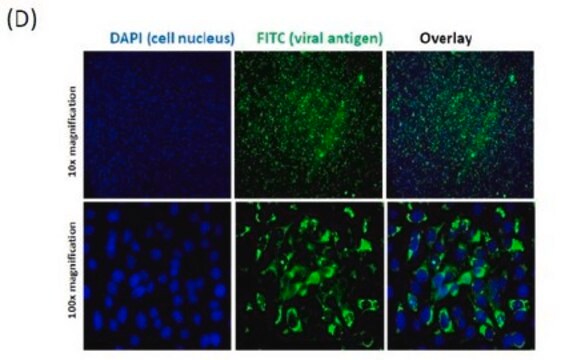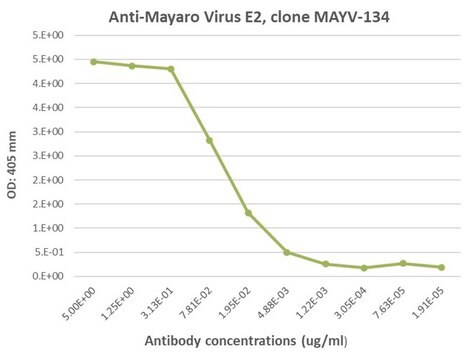MABF2733
Anti-Chikungunya virus E2 Antibody, clone CHK-152
About This Item
Produtos recomendados
fonte biológica
mouse
Nível de qualidade
conjugado
unconjugated
forma do anticorpo
purified antibody
tipo de produto de anticorpo
primary antibodies
clone
CHK-152, monoclonal
peso molecular
calculated mol wt 138.07 kDa
purificado por
using protein G
reatividade de espécies
virus
embalagem
antibody small pack of 100 μL
técnica(s)
ELISA: suitable
inhibition assay: suitable
neutralization: suitable
Isotipo
IgG2κ
sequência de epítopo
Unknown
nº de adesão UniProt
Condições de expedição
dry ice
modificação pós-traducional do alvo
unmodified
Descrição geral
Especificidade
Imunogênio
Aplicação
Evaluated by ELISA with recombinant Chikungunya Virus E2 Envelope Protein.
ELISA Analysis: Various dilutions of this antibody detected recombinant Chikungunya virus E2 protein.
Tested Applications
Surface plasmon resonance: A representative lot detected Chikungunya virus E2 in Surface plasmon resonance applications (Pal, P., et al. (2013). PLoS Pathog. 9(4):e1003312).
Neutralizing Analysis: A representative lot neutralized CHIKV and protected immunocompromised mice against disease. (Pal, P., et al. (2013). PLoS Pathog. 9(4):e1003312).
ELISA Analysis: A representative lot detected Chikungunya virus E2 in ELISA applications (Zhang, R., et al. (2019). Cell Rep. 28(10):2647-2658.e5).
Inhibition Analysis: A representative lot inhibited CHIKV infection when added after virus adsorption to cell surface. (Pal, P., et al. (2013). PLoS Pathog. 9(4):e1003312).
Note: Actual optimal working dilutions must be determined by end user as specimens, and experimental conditions may vary with the end user
forma física
Armazenamento e estabilidade
Outras notas
Exoneração de responsabilidade
Não está encontrando o produto certo?
Experimente o nosso Ferramenta de seleção de produtos.
Código de classe de armazenamento
12 - Non Combustible Liquids
Classe de risco de água (WGK)
WGK 2
Ponto de fulgor (°F)
Not applicable
Ponto de fulgor (°C)
Not applicable
Certificados de análise (COA)
Busque Certificados de análise (COA) digitando o Número do Lote do produto. Os números de lote e remessa podem ser encontrados no rótulo de um produto após a palavra “Lot” ou “Batch”.
Já possui este produto?
Encontre a documentação dos produtos que você adquiriu recentemente na biblioteca de documentos.
Nossa equipe de cientistas tem experiência em todas as áreas de pesquisa, incluindo Life Sciences, ciência de materiais, síntese química, cromatografia, química analítica e muitas outras.
Entre em contato com a assistência técnica








